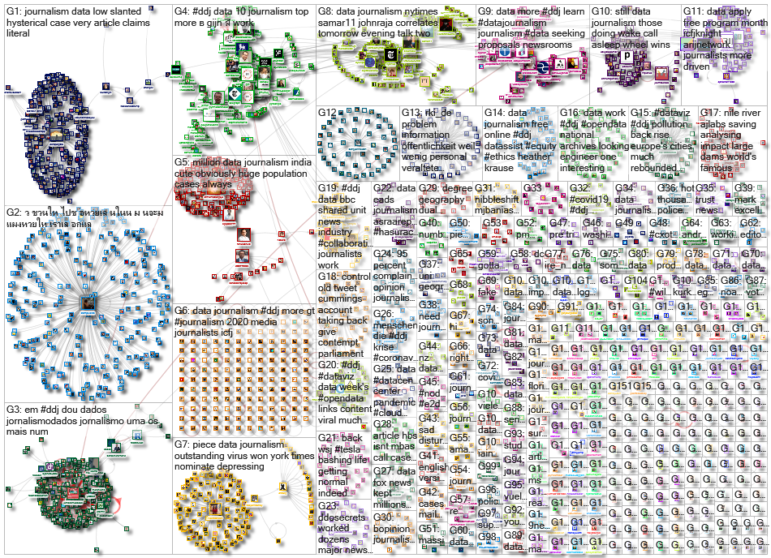During the pandemic, data and graphics reporters are playing key roles in helping to communicate the threat posed by COVID-19. Our NodeXL #ddj mapping from June 22 to 28 finds The New York Times analyzing travel patterns and genetic data to show how the disease spread across the United States, and the impact it has had on nursing homes and elderly care facilities. The Washington Post is responding to the increasing importance of visual data communication by expanding its data and graphics team, the Google News Initiative announced its 2020 fellowships, and the Pulitzer Center is calling for data journalism story proposals.
How COVID-19 Spun Out of Control in the US
In mid-February, there were only 15 known cases of COVID-19 in the US. But that was only a small part of the picture. There were already an estimated 2,000 hidden infections in major cities. The New York Times analyzed travel patterns, hidden infections, and genetic data to show how the epidemic spun out of control in the country.
For those without NYT subscriptions, a taster. Watch how vast city-wide outbreaks are tracked back to single infected travellers. Now think about all the places those visitors to Bournemouth’s beaches came from yesterday… pic.twitter.com/UouWYoRzU9
— Carole Cadwalladr (@carolecadwalla) June 26, 2020
Coronavirus Deaths in Nursing Homes
The New York Times compiled a database of residents and workers who have died from COVID-19 in nursing homes and other long-term care facilities for older adults in the US, revealing alarming figures and trends. Danielle Ivory shares some behind-the-story information in this tweet thread.
Deaths in nursing homes and other long-term care facilities now represent at least 43% of coronavirus deaths in the US pandemic. The @nytimes has been tracking cases and deaths in the homes since March. You can look up the biggest known outbreaks, here: https://t.co/QNHqNWjrgx
— Danielle Ivory (@danielle_ivory) June 27, 2020
Investing in Data Teams
During the pandemic, data and graphics reporters have been at the forefront of the media in helping to communicate clearly the threat and the spread of the coronavirus to readers. The Washington Post announced an expansion of its graphics and design teams with 14 new positions, reflecting the rising importance of visual data communication. The Los Angeles Times’ data graphics editor Ben Welsh chimed in to reiterate the value of data journalists.
A wake-up call for those still asleep at the wheel. Data journalism wins readers and makes money.
If you're still asking your graphics desk to decorate A1 pitches with bars and lines, don't expect to be doing it much longer. https://t.co/L3Hdi6Ta0d
— Ben Welsh (@palewire) June 26, 2020
Identity Theft
This 2019 investigation by Pointer, the Dutch data journalism group, began with a dodgy email. The team takes you on a journey into how they unraveled a murky world of identity theft and scams through online sleuthing. The story won the 2020 Sigma Award for Best Visualization (small newsrooms). Find out how they did it here.
Check out the English version (translated by yours truly) of this epic digital sleuthing that started with an innocent email & revealed an international network of bots & shell companies across at least 14 countries by @Peterkeizer for @pointer_kroncrv https://t.co/mSG5b8f8Mu
— Traci White (@thetraciest) July 12, 2019
Winning the Lottery vs. Struck By Lightning
This “Lottery” interactive that was created during a Visualize Corruption: Data Journalism Hackathon in Thailand in 2016 has resurfaced on Twitter recently. Using government lottery data, it shows the audience the slim probability of winning the lottery and dives into who really gets rich from lottery ticket sales.
ชวนให้ไปซื้อหวยเล่นในนี้ https://t.co/GFh3buL3sT มันจะมีแผงหวยให้เราเลือกแล้วตามดูสถิติว่าเลขนี้เคยถูกบ้างไหม โอกาสถูกหวยเราเป็นเท่าไร แล้วลองเลื่อนลงไปดูว่าเงินที่เราซื้อหวยแต่ละงวดเงินมันไปเข้ากระเป๋าใครบ้าง เป็นโครงการ Visualize Corruption : Data Journalism Hackathon ของไทย pic.twitter.com/dA53XteWDw
— Syncamore Tree (@stampwords) June 28, 2020
Google News Initiative Fellows
The Google News Initiative Fellowship announced its 2020 cohort — 40 young journalists who will join data, product, audience development, and fact-checking teams across Europe.
🎉 Meet our @GoogleNewsInit Fellowship cohort 2020! We received hundreds of applications, and now we're thrilled to introduce the 40 selected fellows. Congratulations to these young talents about to start their career and thank you to everyone who applied. https://t.co/LPWCu5IzCq
— European Journalism Centre (@ejcnet) June 25, 2020
Using Data to Tell Better Stories
The Bangalore International Centre brought together Indian data journalists Pramit Bhattacharya, Rukmini Shrinivasan, and John Samuel Raja to talk about the rise of data journalism to tell better stories in an attention-deficit, fake news era. The session was moderated by Samar Halarnkar, an editor from GIJN member organization IndiaSpend.
I really enjoyed this conversation on data journalism with two good friends @pramit_b and @johnraja , moderated wonderfully by @samar11, whose smart framing made me realise I had strong feelings about data and fake news, and the low bar for open data https://t.co/zrzxHaXsfw
— Rukmini S (@Rukmini) June 28, 2020
Data Journalism Opportunities
The Pulitzer Center is still seeking proposals for stories with original data collection or analysis and strong visuals. Contact Pulitzer’s senior strategist Steve Sapienza if you need more information. In other opportunities: Reuters is looking for a legal data reporter in the US, and Gênero e Número is offering a graphic design intern position in Brazil.
Opportunity for freelance journalists: we are seeking proposals that will employ advanced data mining techniques to create compelling data-driven storytelling. It should also embrace collaboration among newsrooms, even across borders. Learn more & apply: https://t.co/8y0gAk7wlC
— Pulitzer Center (@pulitzercenter) June 27, 2020
Data Journalism Podcasts
Check out Datajournalism.com’s Conversations with Data podcasts. There are nine episodes so far, featuring chats with data journalists and data scientists like Google’s Simon Rogers, Excella’s Amanda Makulec, the Centre for Humanitarian Data’s Leonardo Milano, and more.
🎙Listen to our interview with Prof. Denise Lievesley to learn about the parallels between #datajournalism and #statistics & how each discipline can enrich each other: https://t.co/POxkC059Mk #podcasts #ddj pic.twitter.com/IIPVA48SXb
— DataJournalism.com (@datajournalism) June 23, 2020
Online Video Tutorials
The School of Data Kyrgyzstan organized a five-day online data journalism conference last month. Here — in Russian — is one of the sessions on new formats in data journalism, including scrolling, talkie, sonification, video, animation, and formats for social networks, featuring speakers Alexander Bogachev, Andriy Gazin, Savia Khasanova, and Kristina Shveda. For English resources, The Journalist’s Toolbox uploaded some 20 short training videos on digital tools on its YouTube channel, including tutorials on scraping data from web pages, and data scraping with Tabula.
Как упаковать дата-историю. Обсуждаем новые форматы в дата-журналистике: скроллителлинг, talkie, сонификация, видео, анимация, форматы для соцсетей. Какой из них стоит выбрать?https://t.co/xRXxlWomEP #ddj #LAMPA2020 pic.twitter.com/phcfysdc6m
— GIJN in Russian (@gijnRu) June 22, 2020
Thanks again to Marc Smith of Connected Action for gathering the links and graphing them. The Top Ten #ddj list is curated weekly.
 Eunice Au is GIJN’s program coordinator. Previously, she was a Malaysia correspondent for Singapore’s The Straits Times, and a journalist at the New Straits Times. She has also written for The Sun, Malaysian Today, and Madam Chair.
Eunice Au is GIJN’s program coordinator. Previously, she was a Malaysia correspondent for Singapore’s The Straits Times, and a journalist at the New Straits Times. She has also written for The Sun, Malaysian Today, and Madam Chair.

